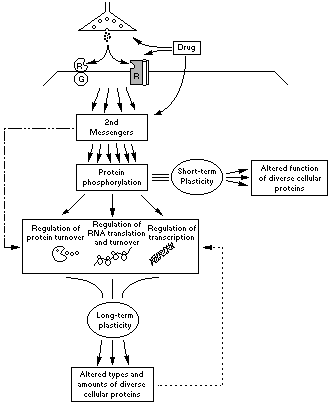
| Figure 1 |
 |
| Scheme illustrating general mechanisms of drug-induced neural plasticity. Psychotropic drugs induce prolonged alterations in brain function (i.e., neural plasticity) by influencing the brain's signal transduction pathways. This occurs regardless of whether the drugs interact initially with proteins involved in presynaptic neurotransmitter function (e.g., cocaine and tricyclic antidepressants as inhibitors of monoamine reuptake transporters), postsynaptic neurotransmitter function [e.g., morphine as an agonist at the opioid receptor (R) which is G-protein (G) coupled, or nicotine as an agonist at the nicotinic acetylcholine receptor (R') which is a ligand-gated channel], or post-receptor signal transduction pathways (e.g., lithium on the cAMP and phosphatidylinositol pathways). The single most important molecular mechanism of neural plasticity is protein phosphorylation. Although neural plasticity is mediated in some situations by other mechanisms of covalent and non-covalent modification (dotted-dashed line), protein phosphorylation is a unique mechanism due to its ubiquity: the number and diversity of neural proteins and processes regulated and the cell types involved. By regulating the phosphorylation state of virtually every type of neural protein, short-term drug exposure produces relatively rapid, usually short-lived effects on diverse aspects of neuronal function. This includes initial drug effects on processes (regulation of protein turnover, RNA translation and turnover, and gene transcription) that determine the types and amounts of proteins present in neurons. With chronic drug exposure, these changes in protein levels lead to long-term neural plasticity as they accumulate and become functionally important. Among the many aspects of drug-induced, long-term neural plasticity are permissive effects, a process whereby chronic drug treatment alters the type, as opposed to the level, of responsiveness of a neuron to the drug itself or other stimuli (dotted line). For example, chronic drug treatment, by inducing the expression of a novel transcription factor, can change the genomic responses elicited by subsequent exposure to the drug or to other acute perturbations. |
| Back to Chapter |
published 2000